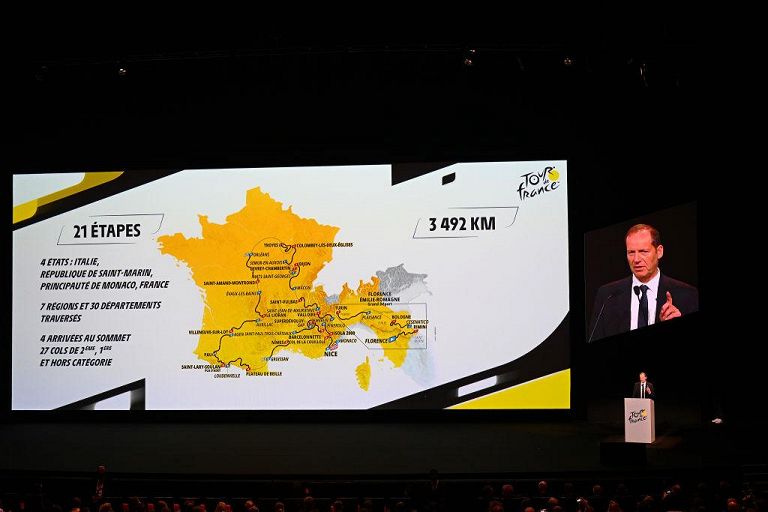The Tour de France 2024presented in Paris, It will leave Florence on June 29th and arrive in Nice on July 21st after a double crossing of the Alps with numerous advances above 2,000 meters. Let’s go From Florence via Tuscany, Emilia Romagna and Piedmont to accompanying the yellow race in France. The route notably includes the Galibier Pass, which separates the French Cottian Alps from the Dauphiné Alps, and the 2,802 meter high peak of the Bonnette, the highest paved road in Europe. It will also be the first time that the Grande Boucle ends outside Paris, a decision determined by the presidential appointment Olympic Games 2024 which will take place from June 26th to August 11th. The first four “Italian” fractions.
The first stage on June 29th will be 206 km long from Florence to Rimini, then it continues with 200 km from Cesenatico to Bologna. The third day takes the group over the longest stage of the Grande Boucle into Piedmont. from Piacenza to Turin for a total of 229 km. The Belpaese will say goodbye to the yellow race on July 2nd when the peloton, which starts in Pinerolo and covers 138 km, will cross the border and arrive in Valloire, after climbing Galibier. Italy will be the protagonist of the Grande Boucle for a few days and then the images of our champions who have written fantastic pages in the history of the sport will return.
200 km for the second faction, dedicated to the “pirate” Marco Pantani, the cyclist who inspired the cycling community, especially uphill. The journey through Emilia-Romagna takes the group to Imola and its race track. Sanctuary of San Luca (1.9 km at 10.6%), for the last part of the traditional final stage of the Giro dell’Emilia, but which we also saw at the Giro d’Italia.
The third stage with its 229 km starts in Piacenza and ends in Turin, will be the longest of the entire Tour, a race suitable for sprinters. On this day, the yellow race is a tribute to Fausto Coppi, Pass through Tortona, the town where the unforgettable champion died on January 2, 1960. Turin, the city that hosted three Tour finishes in 1956, 1961 and 1966 and a stage start in 1996.
With the fourth stage we “cross” France, Italy, departure from Pinerolo and arrival in Valloire, with a short but frightening section of 138 km and the overall classification, mountains that are not so easy to climb could already arise on this day: Sestriere, Montgenevre and Galibier. This will be the first opportunity to challenge the men in the rankings.
Christian Prudhomme, director of the Tour de France
The seventh faction, from Nuits-Saint-Georges to Gevrey-Chambertin, is the first time trial (25 km), while on July 7th the Grand Boucle runs over 14 sections of unpaved roads with a total length of 32 kilometers. After the first day of rest, a short break, then the eleventh stage with Col de Neronne, Puy Mary Pas de Peyrol and Col de Pertus before arriving in the Pyrenees: We start with Tourmalet, Hourquette d’Ancizan and arrive in Pla d’Adet the next day – July 14th, the French national holiday The 15th stage leads here via Peyresourde, Col d’Agnes and Port de Lers before the final climb to the Plateau de Beille. The runners then have the second and final opportunity to recharge their batteries before the grand finale: 17th stage with Col Bayard and Col du Noyer, in the 19th you climb the Col de Vars and then La Bonette, which at 2802 meters is the highest peak on the entire route. But the last two tests could decide the games: The 20th stage includes the Col de Braus, the Col de Turini, the Col de la Colmiane and the arrival at the Col de la Couillole with a final climb of 15.7 km and an average gradient of 7.1%.
Last but not least, July 21st 34 km individual time trial between Monaco and Nice, which is set to replace Paris as the Olympics begin five days later. A difficult route that makes it almost impossible to think of a Giro-Tour combination, but guarantees a spectacle on paper: Jonas Vingegaard and Tadej Pogacar will fight, but watch out for the possible third wheel, from Remco Evenepoel to Primoz Roglic.
 Getty Images
Getty Images Christian Prudhomme, director of the Tour de France
“France is known abroad for Paris and the Côte d’Azur. Without the capital, we had to go to Nice, which also has a great cycling tradition.” Said the director of the Tour de France, Christian Prudhomme, presented the 2024 route. Nice will be the finale of a race whose attractions also include unpaved roads. Inspired by the classic Italian Strade Bianche, the novelty is presented on the ninth stage, on the eve of the first day of rest, in the middle of the Champagne vineyards. On the winegrowing roads, cyclists have to overcome 14 unpaved sections over a total length of 32.2 kilometers. “It’s a way to break the monotony,” says Prudhomme, “to avoid a series of flat stages that end in “sprints.” “We couldn’t ride on paved sections, so we resorted to these unpaved roads, which are the latest big innovation in cycling.”
The Tour de France director said the unpaved road will force teams to select their riders based on that stage as well, which in this case would also break the pattern of leaders and chasers for the mountains. It will be a mountain tour with a total altitude difference of 52,230 meters between Italy, San Marino, France and Monaco, seven mountain stages and four altitude destinations, a total of 27 major peaks, three in the Apennines, one in the Italian Alps, twelve in the French Alps, three in the Massif Central and eight in the Pyrenees. “It’s a less mountainous tour than last year’s tour (which included 30 climbs),” says Prudhomme, “but that doesn’t mean it’s less challenging.”